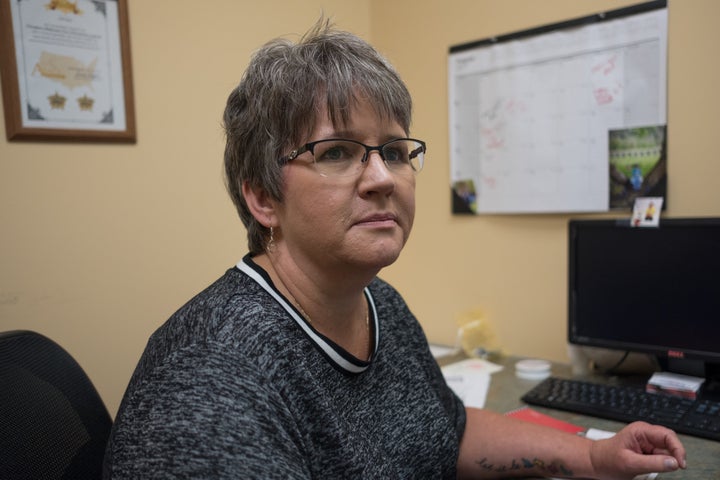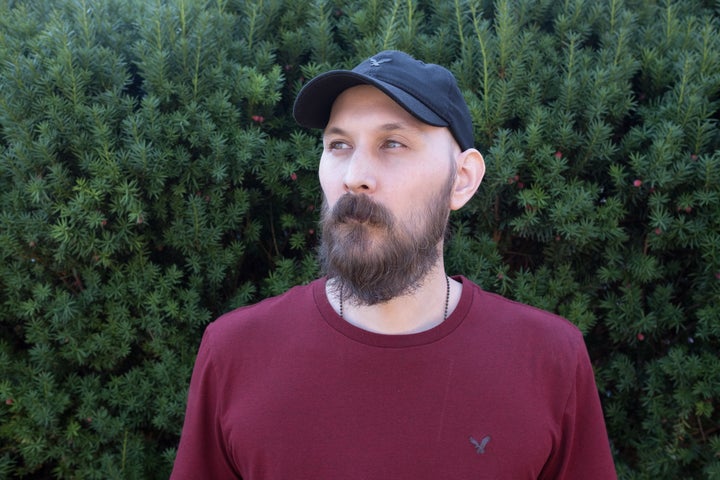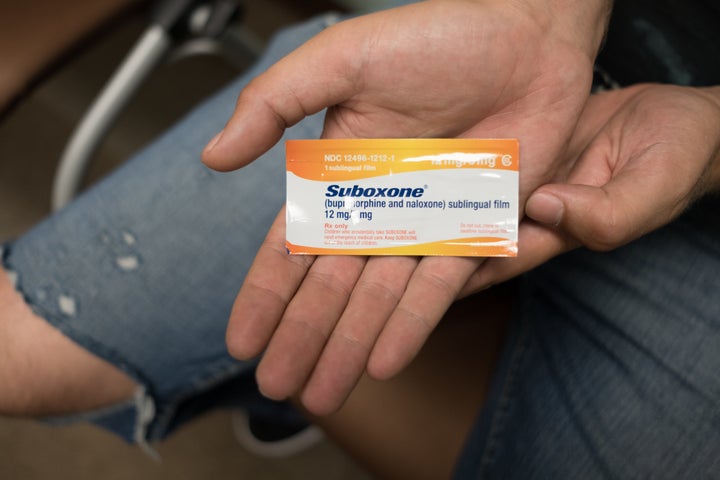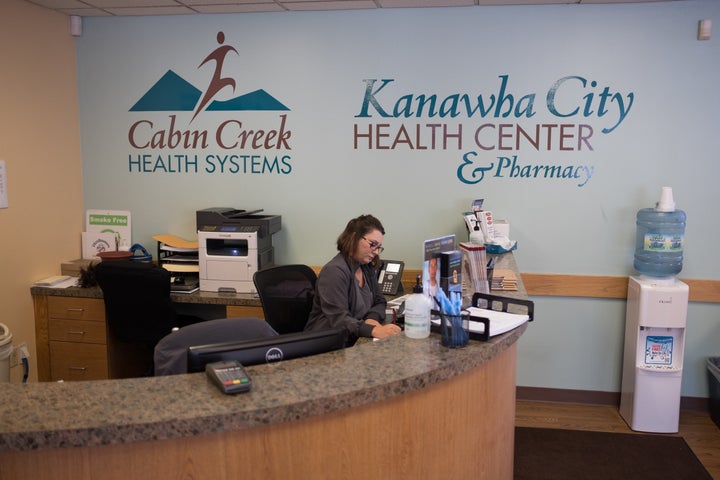This is the third episode in the HuffPost podcast series “I’m Still Here,” which visits communities whose tales of adversity have put them on the map and explores what “survival” in America really looks like. In this episode, “An Epidemic of Epidemics,” Nick Wing travels to West Virginia to meet two men recovering from opioid addiction in the state hit hardest by the epidemic.
***
CHARLESTON, W.Va. ― Afternoons were quieter in Lois Vance’s neighborhood this summer. In years past, she would hear kids outside enjoying their vacation, playing in front yards or biking down the streets of Cabin Creek. No longer. There are many ways to measure the effect of the opioid crisis on West Virginia. One measure is the silence outside Vance’s house.
“All of the people have lost their children because they’re drug addicts and the state has come in and taken all of them,” Vance said. “We’ll never get them back.”
Vance’s 5-year-old grandson, her daughter’s child, is one of the few kids remaining. He and his mother live with Vance, 59.
“We are losing a whole generation and probably two generations of people,” she said.
The lifelong West Virginian has watched the opioid epidemic spread despair across the state over the last two decades.

“I was one of those people that sat back and watched this grow and watched this get worse and watched the children and the neighborhood shrink,” Vance recalled. “I kept saying, ‘Somebody needs to do something.’”
In 2016, Vance, who trained as a counselor, took it upon herself to help. She’s now the care manager for the medication-assisted treatment (MAT) program at Cabin Creek Health Systems, a program that is currently run out of the company’s Charleston clinic. With her glasses and cropped salt-and-pepper hair, Vance exudes compassion and commands respect. Using a combination of drug replacement and behavioral health therapies, she and her colleagues have made positive strides in the fight against opioid addiction.
But they’re fighting an uphill battle.
West Virginia now leads the nation in drug overdose deaths per capita. In 2016, 818 people fatally overdosed in the state, a nearly 13 percent increase over 2015. About 86 percent of those incidents involved at least one opioid, meaning these drugs are now killing more West Virginians each year than traffic accidents and firearms combined.
The damage from opioids extends far beyond overdoses, as the generational decay in Vance’s neighborhood shows. Michael Brumage, executive director of the Kanawha-Charleston Health Department and an assistant dean at West Virginia University’s School of Public Health, estimates that between 80 and 90 percent of his daily work is now devoted to some aspect of the opioid epidemic. He calls it the greatest public health threat of his lifetime.
“This is not an epidemic, but it’s an epidemic of epidemics,” Brumage said. “It’s overdoses; it’s neonatal abstinence syndrome; it’s hepatitis C, which is now the number one infectious killer in the United States; it’s the children who have been abandoned because one or both parents are using; it’s the foster care system being flooded with children.”
As the crisis has mounted, so have the calls for action in West Virginia and across the U.S. While many people agree that something needs to be done, however, they don’t see eye to eye on what exactly that course of action should be.
Vance, Brumage and many other medical professionals view MAT as a critical tool in this battle. Studies have shown prescription medicines to be among the most effective methods of treatment for opioid addiction, especially when combined with behavioral therapy — a way of easing people through the period in which they know they need help, but have difficulty resisting drugs. Yet these medications continue to face a crippling stigma among lawmakers, community members and even many in the field of addiction recovery, who have long held up total abstinence as the only path to wellness.
Amid this resistance, the few comprehensive MAT programs in West Virginia find themselves struggling to serve a virtually unending supply of patients. The health care and criminal justice systems effectively set up most people addicted to opioids for failure, allowing only the luckiest few to get the best shot at a successful recovery. Such is the state of the crisis in West Virginia: Even programs designed to address the deprivation and precariousness of living with addiction are themselves subject to deprivation and precariousness.
“This is not an epidemic, but it's an epidemic of epidemics.”
- Michael Brumage, executive director of the Kanawha-Charleston Health Department
For many teens growing up in Cedar Grove in the 1990s, there were just two options after school: play sports or get high. Greg Carpenter was good at both.
“Football and basketball. Ninth grade, I was getting letters of interest from Division I schools,” he said.
Carpenter, now 38, peers out from under a tattered West Virginia University cap and takes a sip of coffee. Caffeine is one of his few vices these days.

“I could go out on the field 60 percent and no one could touch me,” he said. “That was before drugs.”
There have long been problems of substance abuse in Cedar Grove, fed by what the town of about 1,000 people doesn’t offer. “Lack of opportunity, lack of economic advantages, lack of quality health care, boredom,” said Carpenter.
Alcohol, marijuana, cocaine and LSD weren’t hard to find when he was younger. Carpenter experimented, as many teens do.
In 1996, Purdue Pharma went to market with OxyContin, a controlled-release opioid painkiller with the active ingredient oxycodone. Purdue aggressively pushed the drug with a promotional campaign that misrepresented the risk of addiction and rewarded doctors for indiscriminate prescribing habits. The pills quickly made their way onto the streets of Cedar Grove.
“That was the end of my life right there,” said Carpenter. “The first time I ever did it, I puked my guts out and then felt better than I’d ever felt in my life.”
Archie Nelson, 41, has a similar story. He grew up in a coal-mining town about 70 miles south of Charleston. When he went to work in the capital city in the late ’90s, the painkiller scene was starting to take off.
“It slowly just became a habit, took over everything,” Nelson said in a slow drawl, a wispy mustache obscuring his mouth.
“I thought heroin was the big bad that you couldn’t come back from it. I’d heard about people dying on it and everything,” he added. “I didn’t know that some of the pills were just as bad, if not worse.”

Once Nelson was on the path to addiction, there was little chance of turning back. Pharmaceutical companies flooded West Virginia with opioid painkillers for years. Between 2007 and 2012, they shipped 780 million doses of oxycodone and hydrocodone into the state, a total of about 430 pills per resident, according to a Pulitzer Prize-winning investigation by Eric Eyre of the Charleston Gazette-Mail.
Many West Virginians now addicted to opioids began taking the painkillers out of legitimate need. But ill-informed or unscrupulous doctors and rogue pharmacists fueled problems of abuse and helped give rise to a thriving black market. Subsequent crackdowns on the pills succeeded only in driving people toward cheaper, more potent alternatives like heroin and, most recently, the synthetic opioid fentanyl.
Although the drugs have remained readily available, help for people like Carpenter and Nelson has not. For more than a decade, the two men fluctuated between periods of unchecked addiction and unsuccessful recovery.
Clinics that offered methadone, one of the first medications used to taper people off heroin, came to West Virginia in the early 2000s. They were expensive, crowded and ineffective for many patients.
“I did that for about six months. I couldn’t stand it. Just being a zombie,” said Nelson. “I’d be sitting here or something, working on the computer. I’d just nod out. Wake up and have my arm raised, like I was in class or something. It was crazy.”
Cash-only clinics popped up soon after, taking advantage of deep gaps in health insurance and Medicaid coverage in West Virginia. Some did a tidy business in addiction treatment, charging a flat fee for each visit, which ultimately made them more money than they’d have earned by billing patients through Medicaid or insurance.
In the mid-2000s, clinic doctors began prescribing Suboxone, a medication that has proved to be one of the most effective forms of treatment for opioid addiction. It combines buprenorphine, another opioid, with naloxone, an opioid antagonist used to reverse overdoses.
“When you are taking Suboxone and you take an opiate, the opioid doesn’t work,” Vance explained. “It actually has a blocker in it.”
But cash-only clinics remained unaffordable for many, and the few health care providers that both offered Suboxone and accepted insurance or Medicaid were overburdened.
“The waiting list was sometimes hundreds deep,” Carpenter said. “If you can’t afford the cash-only and you’re sitting on a waiting list at number 422, you’re going to do something. You’re going to use or you’re going to try to get better on your own.”
At some clinics, doctors began handing out Suboxone without examinations or follow-up, moving desperate people through with assembly-line efficiency. Some legitimate patients were forced to resell a portion of their medication just to pay for the visit. Others abused the lax system to make a buck. Many black-market customers were struggling with addiction and trying to help themselves.

Faced with a treatment system drastically under-equipped to handle the severity of the state’s opioid epidemic, Carpenter and Nelson continued to struggle alongside thousands of their fellow West Virginians.
“I had a gun in my hand one night and thought real hard about it,” said Carpenter. “I don’t know why I didn’t. There was a lot of nights I took mixed things you shouldn’t mix, took a lot of things I shouldn’t have taken anyway, and again, by the grace of God, I woke up the next morning.”
Although Carpenter and Nelson managed to survive, it wasn’t until they met Lois Vance that they truly began to rebuild their lives.
“If you can’t afford the cash-only and you’re sitting on a waiting list at number 422, you’re going to do something. You’re going to use or you’re going to try to get better on your own.”
- Greg Carpenter
Every Wednesday, Vance sets up at the harm reduction clinic in downtown Charleston and talks to drug users coming in to exchange dirty syringes.
“I say, ‘Have you thought about being in recovery?’ I’ve had one person tell me no,” said Vance. “They start crying. They say, ‘Yes, I just don’t know how to go about that.’ They want it. They want it badly. There’s not enough programs to help them legitimately.”
For people struggling with opioid addiction, deciding to seek help is only the first crucial step in a potentially lifelong process. Sticking with a recovery program can be incredibly hard. Only 10 percent of those suffering from substance use disorders receive care in a given year, and the path to recovery only gets more difficult when there’s no guarantee that a treatment facility will be ready when you are. Many people end up in 12-step or abstinence-based treatment programs, which give them a lower chance of success ― around 10 percent or less for many programs. And with each failure comes a deeper hopelessness and an increased risk of overdose.
Cabin Creek Health Systems can’t help everyone who comes in. Under federal guidelines, doctors can take only 30 Suboxone patients in the first year of prescribing. After 12 months, they can petition to have that cap raised to 100 patients, which the Charleston clinic’s prescribing physician did successfully in August. After another year, that limit can rise again to 275 patients.
But serving that many people with opioid addiction simply isn’t feasible for many facilities. Medication-assisted treatment is only one of Cabin Creek’s services. The prescribing doctor in Charleston has a full slate of primary care patients, and managing hundreds of individuals in a MAT program would be a full-time endeavor.
With the demand for care outpacing its availability, Cabin Creek first screens interested patients with medical tests and a meeting with an addiction specialist. Then it puts them on a waiting list.
“I have patients on that list that I never hear from again. Those are the patients that I know don’t really want help,” Vance said. “The more they call me, the more I know that they really want in here.”
Patients who end up making it into the treatment program typically experience a rough introduction.
“They come in here in full-blown withdrawals, because we’re required to have them in withdrawal for 24 hours” before we start prescribing for them, said Vance. “They are throwing up, they have diarrhea, they have the shakes, they have the sweats.”
Patients receive medication to ease those symptoms and are observed to determine proper dosages. They come back the next day, at which point a doctor may prescribe a week’s worth of Suboxone. If everything goes well, patients remain on a therapeutic dose of Suboxone for 12 months, before Cabin Creek determines the next step forward.
Patients are required to attend at least four Narcotics Anonymous or Alcoholics Anonymous meetings a week as long as they’re in treatment at Cabin Creek. Every time they have an appointment at the health center, they must provide urine before a witness, which will then be tested for drugs, and their prescriptions are checked to make sure they’re not diverting their supply to the black market. They also attend monthly one-on-one therapy sessions.
But Suboxone remains the most controversial element of treatment at Cabin Creek. It’s also one of the most essential, according to many patients and doctors.
“Most of these NA meetings look down on Suboxone,” Carpenter said. “They say you’re not truly sober and clean, but you are. That’s just simply not true. We’re not walking around high. We’re walking around feeling like we’ve felt before active addiction.”
This misunderstanding about how Suboxone works even persists within some parts of the medical community, said Vance. Tom Price, then secretary of health and human services, denounced medication-assisted treatment as “substituting one opioid for another” when he was in Charleston earlier this year. Experts in treating opioid addiction were appalled. Price also hosted a listening session during his visit, but no MAT patients or administrators were in attendance.
State and federal officials have freed up small chunks of funds for MAT programs in recent months, but it’s unclear how much that will help West Virginia. A state bill passed earlier this year offered money only to MAT programs that run no more than 24 months and limited funds to the first three months of medication. In September, the federal government announced $144.1 million in grants to address the opioid crisis, $35 million of which was designed to expand access to MAT. West Virginia received none of this money.
The lack of urgent investment in a leading treatment would seem unimaginable if this were any other disease.
“We look at Suboxone as a maintenance medication, not a drug,” Vance said. “It’s much like giving a diabetic insulin. While you are giving them a medication, it is keeping them from using an illicit drug.”
Although the goal is to taper patients down and ultimately off Suboxone, she said Cabin Creek doesn’t pressure them to give up the medication.
“It may take two years, it may take three years, to get that patient backed off that medication,” Vance said. “Sometimes that patient may stay on that medicine for the rest of their life.”

The multipronged structure of Cabin Creek’s MAT program and the personal dedication of employees like Vance have given Carpenter and Nelson their best chance at recovery, they both say.
Where he was once, in his own words, “a real prick,” Nelson’s life is finally getting back on track. When his teenage son goes off to college in a few years, Nelson wants to attend gunsmithing school.
Over the past year, he’s been able to rekindle his relationship with his mother.
“She thinks she got her son back,” Nelson said.
For now, Carpenter is enjoying being a father to his 4-year-old daughter. He calls her his “shadow.”
“I’m just now creeping off the precipice of the abyss. Just now starting to be really physically and mentally stable and well and normal,” said Carpenter. “But I’m not out of the woods. It just takes one mistake.
“If an addict is lucky, one time in their life they’ll get a chance to get in a program of this quality, of this magnitude, like the one I’m in now.”
“I’m Still Here” is a HuffPost Podcast hosted by Zeba Blay and produced by Nick Offenberg and Jessica Samakow. Send us an email at stillhere@huffpost.com.
Subscribe: Apple Podcasts // Google Play // RadioPublic // Stitcher // Acast // RSS
